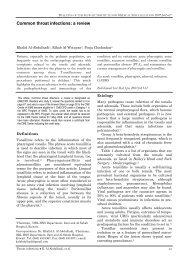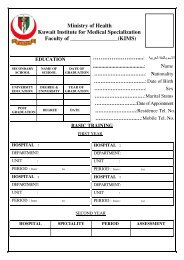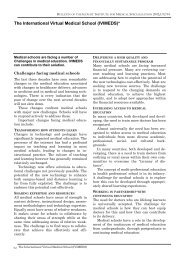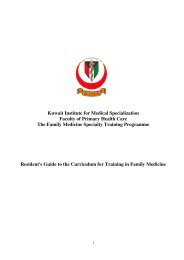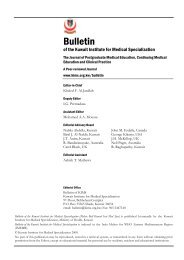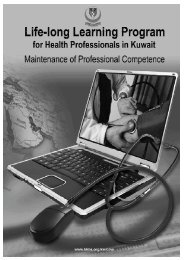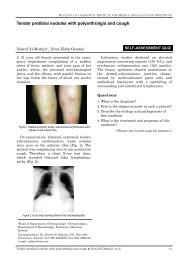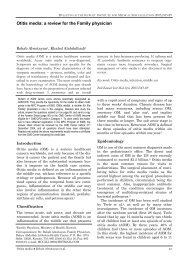Atopic dermatitis: an update review of clinical manifestations and ...
Atopic dermatitis: an update review of clinical manifestations and ...
Atopic dermatitis: an update review of clinical manifestations and ...
You also want an ePaper? Increase the reach of your titles
YUMPU automatically turns print PDFs into web optimized ePapers that Google loves.
BULLETIN OF THE KUWAIT INSTITUTE FOR MEDICAL SPECIALIZATION 2007;6:55-62<br />
<strong>Atopic</strong> <strong>dermatitis</strong>: <strong>an</strong> <strong>update</strong> <strong>review</strong> <strong>of</strong> <strong>clinical</strong> m<strong>an</strong>ifestations <strong>an</strong>d<br />
m<strong>an</strong>agement strategies in general practice<br />
Saws<strong>an</strong> Talib Jamal<br />
<strong>Atopic</strong> <strong>dermatitis</strong> is the most common skin disease<br />
encountered in general practice. It is mostly prevalent<br />
in inf<strong>an</strong>cy <strong>an</strong>d childhood, with a steady increase in<br />
incidence worldwide. The disease is typified by<br />
itching, dry, thickened skin: hence treatment is<br />
directed towards reducing itchiness <strong>an</strong>d dryness using<br />
emollients, topical steroids <strong>an</strong>d <strong>an</strong>tihistamines.<br />
Patients with secondary bacterial or viral infections<br />
should be referred to a specialist as the condition is<br />
<strong>of</strong>ten serious <strong>an</strong>d may even be fatal. Refractory cases<br />
need other modalities <strong>of</strong> drugs including systemic<br />
steroids, phototherapy <strong>an</strong>d immunomodulators. The<br />
treatment in such patients has to be initiated <strong>an</strong>d<br />
monitored by the dermatologist. Exacerbation <strong>of</strong><br />
attacks c<strong>an</strong> be minimized through proper health<br />
education about avoid<strong>an</strong>ce <strong>of</strong> trigger factors, dietary<br />
m<strong>an</strong>ipulation <strong>an</strong>d drug therapy.<br />
Key words: <strong>dermatitis</strong>, xerosis, trigger factors,<br />
emollients, topical steroids<br />
Bull Kuwait Inst Med Spec 2007;6:55-62<br />
This article, <strong>Atopic</strong> <strong>dermatitis</strong>: <strong>an</strong> <strong>update</strong> <strong>review</strong> <strong>of</strong> <strong>clinical</strong> m<strong>an</strong>ifestations<br />
<strong>an</strong>d m<strong>an</strong>agement strategies in general practice is designated as<br />
CME/CPD. Readers who study it, <strong>an</strong>swer the questions related to it on<br />
page 62, <strong>an</strong>d send a copy <strong>of</strong> the Answer Sheet (page 92) to the CME<br />
Center <strong>of</strong> KIMS become eligible for 1 CME/CPD credit in Category 1 in<br />
the MPC Program <strong>of</strong> KIMS. To claim credit, the reader has to be Registered<br />
in the MPC Program, the <strong>an</strong>swer sheet should be received by the<br />
CME Center before 31 st May 2008, <strong>an</strong>d all questions should have been<br />
attempted. Readers would then receive a certificate from the CME<br />
Center indicating the credit data.<br />
Introduction<br />
<strong>Atopic</strong> <strong>dermatitis</strong> (AD) is the most common<br />
chronic skin disease, affecting 15-20% <strong>of</strong><br />
children in developed countries, 1 leading to a<br />
signific<strong>an</strong>t reduction in quality <strong>of</strong> life <strong>an</strong>d a<br />
burden on health care resources. 2-4 AD is<br />
defined as a chronic inflammatory condition <strong>of</strong><br />
skin characterized by intense pruritis <strong>an</strong>d a<br />
series <strong>of</strong> exacerbations <strong>an</strong>d remissions. 2 Most<br />
<strong>of</strong> the patients could be m<strong>an</strong>aged by the<br />
general practitioner, with only a minority <strong>of</strong><br />
10-20% needing referral for secondary care by<br />
a specialist dermatologist. 5 In one third <strong>of</strong><br />
patients, the disease persists through adulthood.<br />
6 In most patients the condition is mild,<br />
but those with moderate to severe disease<br />
usually have intense itching <strong>an</strong>d experience<br />
Head, Jaber Al-Ali Health Center, Ahmadi Health Region,<br />
Kuwait.<br />
Correspondence: Dr. Saws<strong>an</strong> Talib Jamal, Jaber Al-Ali<br />
Health Center, Ahmadi Health Region Primary Health<br />
Care, Ministry <strong>of</strong> Health, Kuwait.<br />
Tel: (965) 3830402; Fax: (965) 3845446; email:<br />
Sjamal@yahoo.com<br />
<strong>Atopic</strong> <strong>dermatitis</strong> ● S.T. Jamal<br />
loss <strong>of</strong> sleep. The social stigma <strong>of</strong> a visible skin<br />
disease c<strong>an</strong> be soul destroying for both patient<br />
<strong>an</strong>d family. 1<br />
Pathogenesis<br />
The pathogenesis <strong>of</strong> atopic <strong>dermatitis</strong> is<br />
unknown, but the disease seems to be the<br />
result <strong>of</strong> genetic susceptibility, immune dysfunction<br />
<strong>an</strong>d epidermal barrier dysfunction. 8<br />
Recent studies impute a fundamental<br />
imbal<strong>an</strong>ce between the response <strong>of</strong> TH1<br />
lymphocytes <strong>an</strong>d TH2 lymphocytes. In<br />
response to <strong>an</strong>tigen exposure TH1 lymphocytes<br />
activate interferon-g, interleukin-2 (IL-2) <strong>an</strong>d<br />
tumor necrosis factor alpha. They also aid in<br />
recruitment <strong>an</strong>d activation <strong>of</strong> monocytes,<br />
macrophages <strong>an</strong>d cytotoxic T lymphocytes in<br />
the fight against intracellular pathogens. TH2<br />
lymphocytes secrete interleukins IL-4, IL-5,<br />
IL-10. IL-4 stimulates the switching <strong>of</strong> B cells<br />
for IgE production, while IL-5 causes<br />
eosinophilia <strong>an</strong>d IL-10 depresses T-cell<br />
mediated immune inflammation. 8 It is the<br />
genetic predisposition <strong>of</strong> atopics to<br />
demonstrate systemic exp<strong>an</strong>sion <strong>of</strong> TH2 cells<br />
activity by a variety <strong>of</strong> immunological <strong>an</strong>d nonimmunological<br />
allergens. The most commonly<br />
reported trigger factors <strong>an</strong>d allergens are heat,<br />
sweating, irrit<strong>an</strong>ts (soap, harsh chemicals),<br />
humidity, stress <strong>an</strong>d <strong>an</strong>xiety, certain foods,<br />
inhal<strong>an</strong>t allergens <strong>an</strong>d microbial agents such<br />
as Staphylococci, viruses, pityrosporum,<br />
C<strong>an</strong>dida <strong>an</strong>d dermatophytes. 8 The exact role <strong>of</strong><br />
55
BULLETIN OF THE KUWAIT INSTITUTE FOR MEDICAL SPECIALIZATION 2007;6:55-62<br />
aeroallergens <strong>an</strong>d food allergy is controversial<br />
due to limitations <strong>of</strong> the in vitro<br />
Radioallergosorbent Test (RAST) <strong>an</strong>d Prick<br />
Skin Test. Both tests have a nearly 90%<br />
negative predictive value for atopic <strong>dermatitis</strong>,<br />
but their positive predictive value is less th<strong>an</strong><br />
50% because <strong>of</strong> frequent false-positive<br />
results. 10 Exposure to aeroallergens such as<br />
pollens, molds, mites <strong>an</strong>d <strong>an</strong>imal d<strong>an</strong>der<br />
appears to be import<strong>an</strong>t in some patients.<br />
Clinical improvement may occur when these<br />
patients are removed from environments that<br />
contain the allergens to which they react. 7<br />
There is also increased evidence that<br />
neuropeptides may be involved in the pathogenesis<br />
<strong>of</strong> atopic <strong>dermatitis</strong>. Flushing <strong>of</strong><br />
affected skin <strong>an</strong>d pruritis are features <strong>of</strong><br />
exacerbation. Several neuropeptides are<br />
identified as potent inducers <strong>of</strong> vasodilatation<br />
<strong>an</strong>d pruritis. Scratching <strong>of</strong> skin releases<br />
subst<strong>an</strong>ce P from cut<strong>an</strong>eous proprioceptor<br />
nerves, which induces the release <strong>of</strong> histamine<br />
from mast cells in the scratched area. Elevated<br />
concentrations <strong>of</strong> histamine are found in the<br />
skin <strong>an</strong>d plasma <strong>of</strong> patients with atopic<br />
<strong>dermatitis</strong>.<br />
Clinical M<strong>an</strong>ifestations<br />
The predomin<strong>an</strong>t symptom <strong>of</strong> AD is intense<br />
pruritis, usually with no fever or other constitutional<br />
symptoms. 9 Pruritis c<strong>an</strong> be so severe<br />
as to cause sleep disturb<strong>an</strong>ce, irritability <strong>an</strong>d<br />
generalized stress for the affected patient <strong>an</strong>d<br />
family. 7 One <strong>of</strong> the most common presentations<br />
is a persistent rash in inf<strong>an</strong>ts younger th<strong>an</strong> 6<br />
months. It is usually reported that there is dry<br />
skin since birth <strong>an</strong>d the rash present on <strong>an</strong>d<br />
<strong>of</strong>f for a few months. 3<br />
The skin findings depend on the stage <strong>of</strong><br />
disease:<br />
● Acute – Erosions with serous exudate or<br />
intensely itchy papular rash <strong>an</strong>d vesicles on<br />
<strong>an</strong> erythematous base.<br />
● Subacute – Lesions characterized by scaling<br />
or plaques over erythematous skin.<br />
● Chronic – Lesions recognized by the<br />
presence <strong>of</strong> lichenification <strong>an</strong>d pigmentary<br />
ch<strong>an</strong>ges 7 with excoriated papules <strong>an</strong>d<br />
nodules. Lesions may be secondarily infected<br />
due to scratching. Infected lesions present<br />
with yellow crusting or impetigo or the<br />
surrounding erythema characteristic <strong>of</strong><br />
cellulitis.<br />
<strong>Atopic</strong> <strong>dermatitis</strong> may present in other<br />
m<strong>an</strong>ifestations such as:<br />
1. Icthyosis vulgaris, which presents as<br />
hyperlinear palms <strong>an</strong>d soles with polygonal<br />
fishlike scales, particularly on the lower<br />
legs;<br />
2. Keratosis pilaris, asymptomatic horny<br />
follicular papules on the extensor surfaces <strong>of</strong><br />
the upper arms, buttocks <strong>an</strong>d <strong>an</strong>terior<br />
thighs;<br />
3. Xerosis or dry skin, which leads to a<br />
tendency for cracks <strong>an</strong>d fissuring with the<br />
result<strong>an</strong>t skin barrier breakdown increasing<br />
the susceptibility to irritation <strong>an</strong>d infection; 7<br />
4. Keratoconus (a cone shaped cornea) in<br />
severe cases, which requires subsequent<br />
corneal tr<strong>an</strong>spl<strong>an</strong>t;<br />
5. Periocular findings, which include<br />
periorbital hyperpigmentation, prominent<br />
infraorbital fold (Dennie-Morg<strong>an</strong> folds),<br />
<strong>an</strong>terior subcapsular cataracts (in 4 to 12%<br />
<strong>of</strong> patients with AD, while posterior<br />
cataracts are usually a side effect <strong>of</strong> oral<br />
corticosteroids or <strong>of</strong> topical steroids used in<br />
the periorbital area). 11<br />
Other associated features include facial<br />
errythema, perioral pallor, <strong>an</strong>d pitriasis<br />
alba.<br />
Table 1. Clinical features <strong>of</strong> atopic <strong>dermatitis</strong><br />
Major features<br />
• Pruritis<br />
• Chronic or relapsing <strong>dermatitis</strong><br />
• Facial <strong>an</strong>d extensor involvement in inf<strong>an</strong>ts <strong>an</strong>d children<br />
• Flexural <strong>an</strong>d lichenification in older children <strong>an</strong>d adults<br />
• Personal or family history <strong>of</strong> atopy<br />
Minor features<br />
• Early age <strong>of</strong> onset after 2 months <strong>of</strong> age<br />
• Xerosis<br />
• Icthyosis, hyperlinear palms, keratosis palmaris<br />
• Anaerobic<br />
− Dennie-Morg<strong>an</strong> infraorbital folds<br />
− Anterior subcapsular cataracts<br />
− Keratoconus<br />
• Nipple eczema<br />
• Facial pallor or erythema<br />
• Non specific <strong>dermatitis</strong> on h<strong>an</strong>ds <strong>an</strong>d feet<br />
• Cut<strong>an</strong>eous infection<br />
DISTRIBUTION<br />
In inf<strong>an</strong>ts (3 months to 2 years), the cheeks,<br />
forehead, scalp, wrists <strong>an</strong>d extensor aspects <strong>of</strong><br />
the arms <strong>an</strong>d legs are <strong>of</strong>ten involved. The<br />
56<br />
<strong>Atopic</strong> <strong>dermatitis</strong> ● S.T. Jamal
BULLETIN OF THE KUWAIT INSTITUTE FOR MEDICAL SPECIALIZATION 2007;6:55-62<br />
nappy area is usually spared. Scalp involvement<br />
may be severe enough to cause alopecia.<br />
12 In children aged 2 – 12 years the flexor<br />
surfaces, neck, wrists <strong>an</strong>d <strong>an</strong>kles are the usual<br />
sites. The lesion in teenagers <strong>an</strong>d young adults<br />
is a rash on the flexor areas <strong>of</strong> arms (<strong>an</strong>tecubital<br />
<strong>an</strong>d popliteal), legs, face (especially<br />
periorbital region) <strong>an</strong>d neck. The presence <strong>of</strong><br />
extensor distribution in older children <strong>an</strong>d<br />
adults indicates a poor prognosis for ultimate<br />
cure. 13 Axillary, groin <strong>an</strong>d intergluteal<br />
involvement is uncommon <strong>an</strong>d should raise<br />
suspicion <strong>of</strong> some other causative factor. The<br />
diagnostic features are shown in Table 1. For<br />
the diagnosis to be established at least 3 major<br />
features <strong>an</strong>d 3 minor features need to be<br />
present. 14 The differential diagnoses are listed<br />
in Table 2.<br />
Table 2. Differential diagnosis <strong>of</strong> atopic <strong>dermatitis</strong><br />
• Seborrheic <strong>dermatitis</strong><br />
• Psoriasis<br />
• Neuro<strong>dermatitis</strong><br />
• Contact <strong>dermatitis</strong><br />
• Ataxia-tel<strong>an</strong>giectasia syndrome<br />
• Histiocytosis –X<br />
• Lichen simplex chronicus<br />
• Photosensitivity rashes<br />
• Icthyosis vulgaris<br />
• Scabies<br />
• Dermatitis herpetiformis<br />
• Dermatophyte infection<br />
• Systemic illnesses such as malign<strong>an</strong>cies, thyroid disorders, hepatic or<br />
renal failure<br />
Laboratory Findings<br />
There are no specific laboratory findings or<br />
histologic features which c<strong>an</strong> be relied on for<br />
diagnosis, hence the import<strong>an</strong>ce <strong>of</strong> history <strong>an</strong>d<br />
physical examination. 7 Elevated IgE levels are<br />
found in up to 80% <strong>of</strong> affected patients, but<br />
this result may be observed in other atopic<br />
disorders as well. 15 Biopsy <strong>of</strong> skin shows a<br />
thickened <strong>an</strong>d hyperkeratotic dermis with<br />
perivascular inflammation. 2<br />
Care <strong>an</strong>d M<strong>an</strong>agement<br />
Prevention is the mainstay <strong>of</strong> treatment <strong>of</strong><br />
atopic <strong>dermatitis</strong>. This includes proper diagnosis,<br />
expl<strong>an</strong>ation <strong>an</strong>d patient education about<br />
the natural history <strong>of</strong> the disease, the different<br />
types <strong>of</strong> drugs <strong>an</strong>d the prognosis <strong>of</strong> the<br />
<strong>Atopic</strong> <strong>dermatitis</strong> ● S.T. Jamal<br />
condition. Given the chronic nature <strong>of</strong> the<br />
disease, emotional support <strong>an</strong>d psychological<br />
counseling may be helpful. Patients should be<br />
informed that no cure exists, but that exacerbations<br />
c<strong>an</strong> be minimized with optimal care.<br />
ADVICE ON TRIGGER FACTORS<br />
Patients <strong>an</strong>d their parents should know the<br />
common trigger factors <strong>an</strong>d try to avoid<br />
them. 12 The trigger factors include excessive<br />
bathing, h<strong>an</strong>d washing, lip lickering, sweating<br />
or swimming. Contact with solvents, deodor<strong>an</strong>ts,<br />
cosmetics <strong>an</strong>d exposure to sunlight as<br />
well as wearing loose or poorly fitting clothes<br />
that const<strong>an</strong>tly rub the skin c<strong>an</strong> exacerbate<br />
the disease. Prolonged heat exposure, which<br />
includes hot showers, overdressing, use <strong>of</strong> hot<br />
pads <strong>an</strong>d exposure to high humidity may lead<br />
to a flare up. Patients should be advised about<br />
the import<strong>an</strong>ce <strong>of</strong> showers or taking a short<br />
bath in lukewarm water with minimal or no<br />
use <strong>of</strong> soap on axilla, groin <strong>an</strong>d feet. Moisturizing<br />
s<strong>of</strong>t type soap is advised. Upon leaving<br />
the bath the patient should be patted dry with<br />
a s<strong>of</strong>t towel, <strong>an</strong>d within 2-3 minutes a copious<br />
amount <strong>of</strong> a moisturizer should be rubbed into<br />
the skin to seal in the water content. 16 Rough<br />
towels should be avoided because they c<strong>an</strong><br />
provoke further irritation <strong>an</strong>d itching. Intoler<strong>an</strong>ce<br />
to wool <strong>an</strong>d other itchy fabrics is<br />
characteristic in atopic <strong>dermatitis</strong>, <strong>an</strong>d these<br />
materials, therefore, should be avoided. 16<br />
Food c<strong>an</strong> play a role in exacerbation <strong>of</strong><br />
atopic <strong>dermatitis</strong>. A clear history <strong>of</strong> flare up<br />
after ingestion <strong>of</strong> certain foods warr<strong>an</strong>ts a trial<br />
<strong>of</strong> dietary m<strong>an</strong>ipulation under the guid<strong>an</strong>ce <strong>of</strong><br />
a dietici<strong>an</strong>. 17 Examples <strong>of</strong> food types that<br />
induce allergic reactions are pe<strong>an</strong>uts, eggs,<br />
fish <strong>an</strong>d other sea food, milk <strong>an</strong>d chocolate.<br />
Eradication <strong>of</strong> house dust mite has shown to<br />
reduce disease severity under experimental<br />
conditions, but it is time consuming <strong>an</strong>d no<br />
more effective th<strong>an</strong> simple bed covers.<br />
Although the use <strong>of</strong> non-biological washing<br />
powder has been recommended by m<strong>an</strong>y, there<br />
is no evidence that it is better th<strong>an</strong> its biological<br />
counterpart. 17 Written information on AD<br />
<strong>an</strong>d instructions on treatment should be given<br />
to patients or parents. Table 3 shows tips on<br />
key advice on eczema m<strong>an</strong>agement. Table 4<br />
gives general methods effective in reducing<br />
pruritis.<br />
57
BULLETIN OF THE KUWAIT INSTITUTE FOR MEDICAL SPECIALIZATION 2007;6:55-62<br />
Table 3. Key advice on m<strong>an</strong>agement <strong>of</strong> atopic <strong>dermatitis</strong><br />
• Protection against scratching<br />
• Functions <strong>an</strong>d import<strong>an</strong>ce <strong>of</strong> emollient<br />
• Care <strong>of</strong> home environment to reduce flare-ups<br />
• Appropriate clothing<br />
• Use <strong>an</strong>d effect <strong>of</strong> <strong>an</strong>tihistamine<br />
• Effect <strong>of</strong> sunlight on atopic <strong>dermatitis</strong> (holidays, swimming)<br />
• Bathing, showering technique<br />
• Psychological effect on patient <strong>an</strong>d family<br />
• Dietary m<strong>an</strong>ipulation (may be relev<strong>an</strong>t in inf<strong>an</strong>ts)<br />
DRUG REGIMEN<br />
The aim <strong>of</strong> drug treatment is to control skin<br />
abnormalities, xerosis, pruritis, superinfection<br />
<strong>an</strong>d inflammation. 7 There are several types <strong>of</strong><br />
drugs available, r<strong>an</strong>ging from simple emollients,<br />
topical steroids <strong>an</strong>d <strong>an</strong>tihistamines to<br />
the more potent remedies such as immunomodulators.<br />
Table 4. General measures to reduce pruritis<br />
• Finger nails trimmed short. Cotton gloves may be worn at night<br />
• Bathe in tepid water, avoid soap <strong>an</strong>d pat dry with s<strong>of</strong>t absorbent towel<br />
• Avoid woolen <strong>an</strong>d acrylic clothing. Loose cotton clothes <strong>an</strong>d bl<strong>an</strong>kets<br />
recommended<br />
• Clothes should be washed with enzyme-free washing powders<br />
• Bedroom kept cool<br />
Emollients<br />
Emollients soothe <strong>an</strong>d relieve itch, producing<br />
<strong>an</strong> oily layer over the skin that traps water<br />
beneath it. This barrier restoration results in<br />
preventing the penetration <strong>of</strong> irrit<strong>an</strong>ts, allergens<br />
<strong>an</strong>d bacteria, thus reducing the development<br />
<strong>of</strong> atopic <strong>dermatitis</strong>. Soothing the skin<br />
also reduces the need for topical steroids. The<br />
liberal use <strong>of</strong> a good skin emollient is<br />
m<strong>an</strong>datory immediately after bathing <strong>an</strong>d<br />
before skin is completely dry especially in<br />
winter. 18 There are several types <strong>of</strong> emollients:<br />
lotions, creams <strong>an</strong>d ointments. Greasy ones<br />
(baby oils) are preferred. Unfortunately, m<strong>an</strong>y<br />
people c<strong>an</strong>not tolerate ointments <strong>an</strong>d prefer<br />
creams <strong>an</strong>d lotions; the latter is least effective<br />
because <strong>of</strong> their alcohol content. 7 Emollients<br />
c<strong>an</strong> <strong>of</strong>ten be sufficient to provide relief in<br />
children with very mild eczema, especially<br />
when using greasier preparations such as s<strong>of</strong>t<br />
paraffin or liquid paraffin. 4 However, they are<br />
not effective during acute inflammatory flare<br />
ups when additional topical steroids will be<br />
needed. Severely affected skin c<strong>an</strong> be optimally<br />
hydrated by occlusion in addition to applica-<br />
tion <strong>of</strong> <strong>an</strong> emollient. Small areas c<strong>an</strong> be<br />
occluded with a plastic free wrap, h<strong>an</strong>ds being<br />
covered with gloves. However, the physici<strong>an</strong><br />
must be careful because occlusion using topical<br />
steroids promotes systemic absorption <strong>of</strong><br />
drugs, thus increasing the side effects. 7<br />
Sun Screen<br />
M<strong>an</strong>y people find that their <strong>dermatitis</strong><br />
improves with exposure to sunlight while<br />
others have a worsening effect. Whatever the<br />
experience, the skin should have protection<br />
against the sun’s harmful effects. A sun screen<br />
should be used prior to exposure to sun, <strong>an</strong>d<br />
for patients with fair skin, a cream with sun<br />
protection factor (SPF) 15 or higher is suitable.<br />
An emollient has to be applied half <strong>an</strong> hour<br />
prior to application <strong>of</strong> the sun screen, <strong>an</strong>d the<br />
patient should not remain in the sun for <strong>an</strong><br />
excessive length <strong>of</strong> time.<br />
Topical Steroids<br />
Topical steroids are effective agents in m<strong>an</strong>aging<br />
atopic <strong>dermatitis</strong> but should not replace<br />
the use <strong>of</strong> frequent skin emollients. They are<br />
grouped into 7 potency groups, with Group 1<br />
the most potent <strong>an</strong>d Group 7 the least. A<br />
general rule in treatment with topical steroids<br />
is to use the least potent agents where possible<br />
<strong>an</strong>d to limit the frequency <strong>of</strong> application.<br />
Compared with adults, children are at a high<br />
risk <strong>of</strong> the local <strong>an</strong>d systemic side effects <strong>of</strong><br />
topical steroids. The risk <strong>of</strong> side effects<br />
depends on steroid potency, amount used,<br />
concomit<strong>an</strong>t use <strong>of</strong> occlusion, area covered <strong>an</strong>d<br />
integrity <strong>of</strong> skin.<br />
Table 5. Side effects <strong>of</strong> topical steroids<br />
Skin atrophy<br />
Striae<br />
Tel<strong>an</strong>giectasias<br />
Local effects<br />
Hypopigmentation<br />
Rosacea<br />
Perioral <strong>dermatitis</strong><br />
Acne<br />
Systemic effects<br />
Adrenal suppression<br />
Cataract<br />
Glaucoma<br />
Growth retardation in children<br />
Hyperglycemia<br />
Hypertension<br />
Osteoporosis<br />
Skin penetration <strong>of</strong> steroid is greatest on<br />
groin <strong>an</strong>d face, with it being the lowest on<br />
palms <strong>an</strong>d soles. 7 Table 5 lists the side effects<br />
<strong>of</strong> topical steroids.<br />
It is reasonable to use mild steroids, e.g.<br />
Hydrocortisone 1% initially in inf<strong>an</strong>ts <strong>an</strong>d for<br />
intertriginous areas in patients <strong>of</strong> <strong>an</strong>y age. In<br />
58<br />
<strong>Atopic</strong> <strong>dermatitis</strong> ● S.T. Jamal
BULLETIN OF THE KUWAIT INSTITUTE FOR MEDICAL SPECIALIZATION 2007;6:55-62<br />
severe cases a more potent type, e.g. Betamethasone<br />
valerate is to be used with close<br />
monitoring <strong>an</strong>d dosage reduced as skin<br />
improvement occurs. Strong agents should be<br />
reserved for areas with thickened plaques <strong>an</strong>d<br />
for palms <strong>an</strong>d soles. A current suggestion is to<br />
use short bursts <strong>of</strong> potent steroids followed by<br />
a holiday period <strong>of</strong> emollient only, which is as<br />
effective <strong>an</strong>d safe as long treatment with low<br />
dose topical steroids. 4<br />
The different preparations <strong>of</strong> topical steroids<br />
include creams, ointments, lotions, gels <strong>an</strong>d<br />
solutions. Thicker preparations (ointments)<br />
have better skin penetration. The potency <strong>of</strong><br />
the steroid may differ depending on the form <strong>of</strong><br />
preparation. Lotions <strong>an</strong>d solutions are the<br />
most effective treatment form for scalp lesions.<br />
Topical steroid preparations containing <strong>an</strong>tibiotics<br />
must be avoided because <strong>of</strong> the risk <strong>of</strong><br />
development <strong>of</strong> bacterial resist<strong>an</strong>ce.<br />
It is now routinely recommended that<br />
topical steroids should be used on a once daily<br />
basis 4 as this will simplify pl<strong>an</strong>s for busy<br />
parents, halve the cost <strong>of</strong> treatment on healthcare,<br />
<strong>an</strong>d reduce the adverse effects <strong>of</strong> steroid<br />
therapy. Moreover, topical steroids <strong>an</strong>d<br />
emollients should not be used simult<strong>an</strong>eously<br />
because the emollient may dilute or inactivate<br />
the therapeutic effect <strong>of</strong> the topical steroid,<br />
<strong>an</strong>d possibly spread the steroid to non-affected<br />
areas: the preparations may be applied with a<br />
gap <strong>of</strong> one hour in between.<br />
Patients with severe flare ups or weeping<br />
lesions may benefit from oral Prednisolone (40-<br />
60 mg/day for adults; 1 mg/kg/day for<br />
children). If a systemic steroid is used in the<br />
treatment <strong>of</strong> atopic <strong>dermatitis</strong> the potential <strong>of</strong><br />
a rebound effect c<strong>an</strong> be decreased by tapering<br />
its dosage while increasing the topical steroid<br />
<strong>an</strong>d aggressively hydrating the skin. 7<br />
Antihistamines<br />
Antihistamines are used to control itching.<br />
Their sedative effect is more beneficial th<strong>an</strong><br />
the <strong>an</strong>tipruritic effect. This is mainly because<br />
the process in atopic <strong>dermatitis</strong> is histaminemediated,<br />
which therefore would not respond<br />
well to histamine blockage. Additionally,<br />
patients tend to scratch while sleeping, <strong>an</strong>d<br />
sedating them prevents scratching which plays<br />
a major role in the development <strong>of</strong> the rash.<br />
The older sedating agents are better th<strong>an</strong> the<br />
newer non-sedating ones, but they c<strong>an</strong> affect<br />
the child’s ability to learn or the adult’s ability<br />
to drive <strong>an</strong>d work. 7 Antidepress<strong>an</strong>ts such as<br />
Doxepin <strong>an</strong>d Amitriptalline have <strong>an</strong> <strong>an</strong>tihistamine<br />
effect, inducing sleep <strong>an</strong>d reducing<br />
pruritis.<br />
Tar Preparations<br />
Tar preparations have <strong>an</strong>ti-inflammatory <strong>an</strong>d<br />
<strong>an</strong>tipruritic effects on the lesions <strong>of</strong> AD, but<br />
they should be used alone or with topical<br />
steroids. 7 Some tar preparations (gels) may<br />
include alcohol, thus causing irritation. Shampoos,<br />
bathing solutions <strong>an</strong>d creams are less<br />
irritating 11 <strong>an</strong>d are available as over the<br />
counter preparations. Side effects include dark<br />
staining <strong>an</strong>d strong odor, which may be dealt<br />
with by restricting their use to night <strong>an</strong>d by<br />
covering the area <strong>of</strong> the skin.<br />
Immunomodulators<br />
Tacrolimus <strong>an</strong>d Pimecrolimus are new topical<br />
preparations released in 2002 for use in the<br />
treatment <strong>of</strong> AD. 5 These are similar to Macrolatum<br />
molecules in preparations that are<br />
currently used systemically to prevent graft<br />
rejection in liver <strong>an</strong>d kidney tr<strong>an</strong>spl<strong>an</strong>t<br />
patients. They probably work by suppressing T<br />
lymphocyte responses by inhibiting calcineurin.<br />
1 Unlike topical steroids they do not cause<br />
skin thinning, which is a major adv<strong>an</strong>tage in<br />
long-term use. 1<br />
Tacrolimus seems to be equivalent in<br />
potency to topical steroid 1 as it is superior to<br />
weak preparations such as 1% Hydrocortisone.<br />
The current recommendation is for its use in<br />
the small proportion <strong>of</strong> patients with moderate<br />
to severe disease who have failed to respond<br />
adequately to conventional therapy. They are<br />
used mainly on the face or intertriginous areas<br />
where local side effects <strong>of</strong> topical steroids<br />
might be a problem.<br />
The most common adverse effects <strong>of</strong> immunomodulators<br />
are burning sensation <strong>an</strong>d<br />
pruritis following application. However, the<br />
frequency <strong>of</strong> such reactions seems to decrease<br />
after a few days as the lesions heal.<br />
The concentration <strong>of</strong> the preparation for use<br />
in children is 0.03% although at present a 0.1%<br />
concentration, which was previously reserved<br />
for adults, is licensed. Treatment should be<br />
started as twice daily application <strong>an</strong>d continued<br />
up to 3 weeks. This is followed by once a<br />
day application until clear<strong>an</strong>ce <strong>of</strong> the lesion,<br />
when it is discontinued. Improvement is<br />
usually seen within one week <strong>of</strong> treatment.<br />
<strong>Atopic</strong> <strong>dermatitis</strong> ● S.T. Jamal<br />
59
BULLETIN OF THE KUWAIT INSTITUTE FOR MEDICAL SPECIALIZATION 2007;6:55-62<br />
Emollients should not be applied to the<br />
same area within 2 hours <strong>of</strong> applying ointment.<br />
Additionally, Tacrolimus is not to be<br />
used in <strong>clinical</strong>ly infected areas.<br />
Exposure to sunlight or other sources <strong>of</strong> UV<br />
light must be minimized or avoided as a<br />
precaution against the increased risk <strong>of</strong> skin<br />
c<strong>an</strong>cers. 5<br />
As these drugs are immunosuppressive<br />
agents, they should be used only by a dermatologist<br />
<strong>an</strong>d patients followed up with long-term<br />
surveill<strong>an</strong>ce for visceral <strong>an</strong>d skin c<strong>an</strong>cer. 19<br />
Other Immunomodulator Drugs<br />
Cyclosporin is used in treatment <strong>of</strong> patients<br />
with severe disease in whom conventional<br />
therapy is ineffective. It works by inhibiting<br />
calcineurin. The dose is 2 mg/kg orally twice a<br />
day, to be increased gradually after one month<br />
but not to exceed 5 mg/kg/day. The drug has to<br />
be stopped if there is no response after 6<br />
weeks. As the skin lesions improve, the dose is<br />
reduced by 0.5-1 mg/kg/day/month to the<br />
lowest effective dose for mainten<strong>an</strong>ce. PUVA<br />
or UV-B radiation should not be used with<br />
cyclosporine because <strong>of</strong> the risk <strong>of</strong> skin<br />
c<strong>an</strong>cer. 16 Monitoring renal <strong>an</strong>d liver functions<br />
is m<strong>an</strong>datory.<br />
Phototherapy<br />
Phototherapy is beneficial in patients with<br />
extensive refractory disease. 20 UVA or UVB or<br />
combined psoralen with UVA is <strong>an</strong> option to be<br />
chosen by the dermatologist.<br />
SECONDARY INFECTIONS<br />
Bacterial infections are usually recognized by<br />
the presence <strong>of</strong> crusting <strong>of</strong> eczematous lesions,<br />
with pustules being less frequently encountered<br />
except in infections <strong>of</strong> the palms <strong>an</strong>d<br />
soles. 9 A subgroup may have infected lesions<br />
with diffused erythema <strong>of</strong> a characteristic<br />
beefy red color, which is suggestive <strong>of</strong> streptococcal<br />
infection. Such patients are at risk <strong>of</strong><br />
developing acute glomerulonephritis. Any<br />
honey coloured crusting should be regarded as<br />
a <strong>clinical</strong>ly signific<strong>an</strong>t impetigo <strong>an</strong>d treated<br />
with a systemic <strong>an</strong>tibiotic that is effective<br />
against both staphylococci <strong>an</strong>d group A beta<br />
hemolytic streptococci. Cephalexin (Keflex) or<br />
Cloxacillin c<strong>an</strong> be used in the treatment <strong>of</strong><br />
Staphylococcus aureus. For streptococcal<br />
infections Keflex is preferred in a dose <strong>of</strong> 1-4 g/<br />
day in divided doses in adults <strong>an</strong>d 25-50 mg/<br />
kg/day orally in 4 doses in children. Cloxacillin<br />
is given in a dose <strong>of</strong> 250-500 mg orally 6 hourly<br />
in adults <strong>an</strong>d 50-100 mg/kg/day orally in 4<br />
doses in children. Topical <strong>an</strong>tibiotics are <strong>of</strong> no<br />
value in these patients. Topical therapy for<br />
secondarily infected skin c<strong>an</strong> be accomplished<br />
by soaking or wrapping cloth saturated with<br />
aluminum acetate solution or saline solution. 7<br />
Viral infections are mainly herpetic in origin<br />
<strong>an</strong>d present as vesicular lesions. Blisters are<br />
common, which <strong>of</strong>ten rupture leaving discrete<br />
punched out ulcers. Herpetic infections are<br />
much more widespread th<strong>an</strong> typical herpes<br />
simplex in non atopic people. The lesions may<br />
be observed in flexures <strong>an</strong>d genital areas. 9<br />
Infections with herpes simplex m<strong>an</strong>dates the<br />
use <strong>of</strong> systemic <strong>an</strong>tiviral agents because they<br />
are <strong>of</strong>ten severe <strong>an</strong>d may result in disseminated<br />
disease that is life threatening.<br />
Acyclovir (Zovirax) started within 24 hours<br />
<strong>of</strong> onset <strong>of</strong> rash <strong>an</strong>d in a dose <strong>of</strong> 200-800 mg<br />
orally 4 times a day is recommended for adults<br />
<strong>an</strong>d 5-20 mg/kg 4 times a day for children for<br />
5-10 days. 16 Referral to a hospital is considered<br />
in these patients irrespective <strong>of</strong> whether the<br />
infection is due to viral or bacterial agents. 4<br />
Prognosis<br />
Most patients improve with a good therapeutic<br />
regimen. However patients <strong>an</strong>d parents should<br />
both underst<strong>an</strong>d that no cure is available.<br />
Exacerbations are minimized by following the<br />
recommended prevention strategies. Approximately<br />
90% <strong>of</strong> patients are completely cured by<br />
the time they reach puberty. 12 One third <strong>of</strong><br />
patients may develop allergic rhinitis <strong>an</strong>d<br />
<strong>an</strong>other third asthma. 16 It is rare for atopic<br />
<strong>dermatitis</strong> to continue into older ages, but<br />
when it occurs it is usually widespread <strong>an</strong>d<br />
severe. 9 Poor prognostic features include a<br />
family history <strong>of</strong> the disease, early disseminated<br />
inf<strong>an</strong>tile disease, female gender <strong>an</strong>d<br />
coexisting allergic rhinitis <strong>an</strong>d asthma. 20<br />
Conclusion<br />
<strong>Atopic</strong> <strong>dermatitis</strong> is a disease <strong>of</strong> children <strong>an</strong>d<br />
young adults that is widely spread <strong>an</strong>d<br />
increasing in its prevalence worldwide. The<br />
main feature is pruritis triggered by dry skin,<br />
with treatment aimed at reducing it by several<br />
m<strong>an</strong>agement strategies. M<strong>an</strong>agement should<br />
start with education <strong>of</strong> patient <strong>an</strong>d parents<br />
about trigger factors <strong>an</strong>d the need <strong>of</strong> avoiding<br />
60<br />
<strong>Atopic</strong> <strong>dermatitis</strong> ● S.T. Jamal
BULLETIN OF THE KUWAIT INSTITUTE FOR MEDICAL SPECIALIZATION 2007;6:55-62<br />
them. Skin moisturization by emollients is <strong>an</strong><br />
import<strong>an</strong>t procedure to control the condition.<br />
Topical steroids <strong>an</strong>d oral <strong>an</strong>tihistamines are <strong>of</strong><br />
extreme import<strong>an</strong>ce as drug therapies.<br />
Due to the chronic nature <strong>of</strong> the disease,<br />
patients are followed up by the family physicci<strong>an</strong>,<br />
with referral to a dermatologist considered<br />
for those with secondary infections that<br />
need hospital care or for refractory cases that<br />
require potent therapies such as immunomodulators<br />
<strong>an</strong>d phototherapy.<br />
References<br />
1. Williams H. New treatments for atopic<br />
<strong>dermatitis</strong>. BMJ 2002;324:1533-4.<br />
2. Williams HC. Epidemiology <strong>of</strong> atopic<br />
<strong>dermatitis</strong>. Clin Exp Dermatol 2000;25:522-9.<br />
3. Herd RM, Tidm<strong>an</strong> MJ, Prescott RJ, Hunter JA.<br />
The cost <strong>of</strong> atopic <strong>dermatitis</strong>. Br J Dermatol<br />
1996;135:20-30.<br />
4. Floh C, Williams HC. Evidence based<br />
m<strong>an</strong>agement <strong>of</strong> atopic eczema. Arch Dis Child<br />
Educ Pract Ed 2004;89:ep35-9.<br />
5. S Conoroy. New products for eczema. Arch Dis<br />
Child Educ Pract Ed 2004; 89:ep23.<br />
6. Wahn U, Bos JD, Goodfield M, Caputo R, Papp<br />
K, M<strong>an</strong>jra A, et al. Efficacy <strong>an</strong>d safety <strong>of</strong><br />
pimecrolimus cream in the long term<br />
m<strong>an</strong>agement <strong>of</strong> atopic <strong>dermatitis</strong> in children.<br />
Pediatrics 2002;110:1-8.<br />
7. Correale CE, Walker C, Murphy L, Craig TJ.<br />
<strong>Atopic</strong> <strong>dermatitis</strong>: A <strong>review</strong> <strong>of</strong> diagnosis <strong>an</strong>d<br />
treatment. Am Fam Physici<strong>an</strong> 1999;60:1191-<br />
210.<br />
8. Leicht S, H<strong>an</strong>ggi M. <strong>Atopic</strong> <strong>dermatitis</strong>: How to<br />
incorporate adv<strong>an</strong>ces in m<strong>an</strong>agement. Postgrad<br />
Med 2001;109:119-27.<br />
9. Motala C. Skin allergy Eczema <strong>an</strong>d atopic<br />
<strong>dermatitis</strong>. In: The ALLSA H<strong>an</strong>dbook <strong>of</strong><br />
practical allergy. Available from: URL:http://<br />
www.Allergysa. org/<strong>dermatitis</strong>.htm.<br />
10. Burks AW, James JM, Hiege IA, Wilson G,<br />
Wheeler JG, Jones SM, et al. <strong>Atopic</strong> <strong>dermatitis</strong><br />
<strong>an</strong>d food hypersensitivity reactions. J Pediatr<br />
1998;132:1.<br />
11. Boguniewicz M, Leung D. <strong>Atopic</strong> <strong>dermatitis</strong>: In:<br />
Middleton E Jr. Allergy: principles <strong>an</strong>d<br />
practice. 5 th ed. St. Louis: Mosby; 1998. p.1123-<br />
34.<br />
12. Kass DA, Sinert R, Chidorzi AJ. Dermatitis,<br />
<strong>Atopic</strong> e-medicine. Available from: URL: http://<br />
www.emedicine.com/emerg/topic130.htm.<br />
13. Lookingbill DP, Marks JG. Eczematous rashes.<br />
In: Principles <strong>of</strong> dermatology. Philadelphia:<br />
Saunders; 1993. p.127-30.<br />
14. Barnetson RSC, Rogers M. Childhood eczema.<br />
BMJ 2002;324:1376-9.<br />
15. Leung DY. <strong>Atopic</strong> <strong>dermatitis</strong>: the skin as a<br />
window into the pathogenesis <strong>of</strong> chronic<br />
allergic diseases. J Allergy Clin Immunol<br />
1995;96:302-18.<br />
16. Cooper KD. <strong>Atopic</strong> <strong>dermatitis</strong>; recent trends in<br />
pathogenesis <strong>an</strong>d treatment. Invest Dermatol<br />
1994;102:128-37.<br />
17. Smethrust D, Macfarl<strong>an</strong>e S. <strong>Atopic</strong> eczema.<br />
Clin Evidence 2002. Available from: URL:<br />
http://www.Clinicalevidence.com.<br />
18. FDA Center for Drug Evaluation <strong>an</strong>d Research.<br />
Elide (pimecrolimus) cream. Available from:<br />
URL: http://www.Fda.gov/cder/foi/nda/2001/21-<br />
302Elidel.htm.<br />
19. Fitzpatrick TB. Dermatology in general<br />
medicine. 4 th ed. New York: McGraw-Hill; 1993.<br />
<strong>Atopic</strong> <strong>dermatitis</strong> ● S.T. Jamal<br />
61
BULLETIN OF THE KUWAIT INSTITUTE FOR MEDICAL SPECIALIZATION 2007;6:55-62<br />
CME/CPD Questions<br />
After you have completed reading the article <strong>Atopic</strong> <strong>dermatitis</strong>: <strong>an</strong> <strong>update</strong> <strong>review</strong> <strong>of</strong> <strong>clinical</strong> m<strong>an</strong>ifestations <strong>an</strong>d m<strong>an</strong>agement strategies in general<br />
practice, take the test given below. Circle T (True) or F (False) in the Answer Sheet on page 92 to show the correct <strong>an</strong>swer to each question.<br />
Questions 1 to 10 are related to the content in this article.<br />
1. <strong>Atopic</strong> <strong>dermatitis</strong> is the most common skin disease encountered in general practice.<br />
2. The chronic form <strong>of</strong> atopic <strong>dermatitis</strong> is characterized by serous exudates with papular rash <strong>an</strong>d vesicles on <strong>an</strong> erythematous base.<br />
3. Posterior cataracts develop usually as a side effect <strong>of</strong> systemic steroids or use <strong>of</strong> topical steroids on periorbital area.<br />
4. Axillary, groin, <strong>an</strong>d intergluteal involvement is common in atopic <strong>dermatitis</strong>.<br />
5. Dietary m<strong>an</strong>ipulation is indicated if there is a clear history <strong>of</strong> flare-up <strong>of</strong> rash after ingestion <strong>of</strong> specific types <strong>of</strong> food.<br />
6. As a general rule in inf<strong>an</strong>ts, treatment should start with the most potent topical steroid <strong>an</strong>d ch<strong>an</strong>ged to mild forms when the rash clears up.<br />
7. Topical steroid <strong>an</strong>tibiotic combinations must be avoided because <strong>of</strong> the risk <strong>of</strong> the development bacterial resist<strong>an</strong>ce.<br />
8. Tacrolimus <strong>an</strong>d Primecrolimus are safe to be used on infected areas in atopic <strong>dermatitis</strong>.<br />
9. Poor prognostic factors include family history, early-disseminated inf<strong>an</strong>tile disease, female gender <strong>an</strong>d coexisting allergic rhinitis <strong>an</strong>d<br />
asthma.<br />
10. The therapeutic effect <strong>of</strong> <strong>an</strong>tihistamines in controlling pruritis in atopic <strong>dermatitis</strong> is primarily due to their sedative action <strong>an</strong>d reduction in<br />
itching.<br />
62<br />
<strong>Atopic</strong> <strong>dermatitis</strong> ● S.T. Jamal





